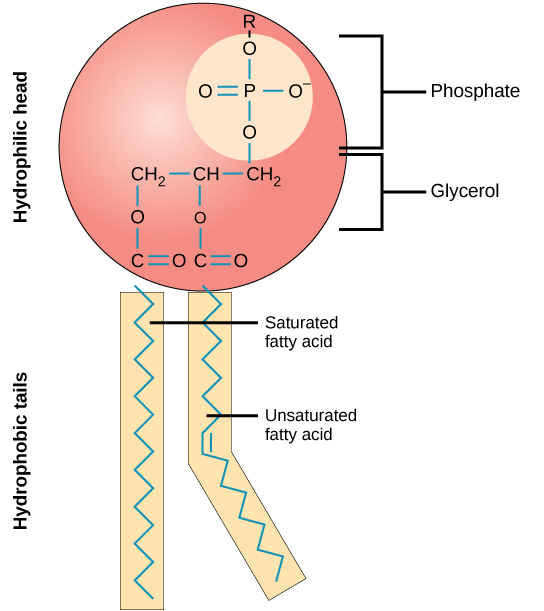The cell membrane is designed in a way that substances having certain properties are unable to enter or leave the cell (this movement across the cell boundary is known as transport). The fluid mosaic model describes how substances, mainly cholesterol, phospholipids and proteins, slide freely in the membrane.
First, let's start with the phospholipid bilayer. A phospholipid a complex lipid with a "head" and a "tail". The head is made of one polar/hydrophilic phosphate group and a glycerol molecule. The tail is made two nonpolar/hydrophobic fatty acid chains. A fatty acid is a long chain of hydrocarbons (one carbon atom bonded to two hydrogen atoms) with a carboxyl group at one end. Glycerol is an alcohol with three carbon atoms.
The phospholipids of the cell membrane are arranged in a bilayer (picture below). The hydrophilic (water-loving) head faces outward, where it has contact with the aqueous solution both inside and outside the cell. The hydrophobic (water-fearing) tail easily interacts with nonpolar molecules, but it interacts poorly with water. Because of this, the fatty acid tails are tucked away in the interior of the membrane to avoid any interactions with water. The chemical nature of the phospholipid bilayer only allows lipid-soluble molecules and some small molecules to freely pass across the membrane; ions and large polar molecules cannot.

________
Image Credit:
(1) “Cell Membrane Detailed Diagram.” Wikimedia Commons, 31 Jan. 2007, commons.wikimedia.org/wiki/File:Cell_membrane_detailed_diagram_en.svg.
(2) OpenStax, CNX. “Phospholipid.” Wikimedia Commons, 27 May 2016, commons.wikimedia.org/wiki/File:Figure_05_01_02.jpg.
(3) OpenStax. “Phospholipid Bilayer.” Wikimedia Commons, 18 May 2016, commons.wikimedia.org/wiki/File:0302_Phospholipid_Bilayer.jpg.


Comments
Post a Comment